Abstract
Studies on circulating T cells and antibodies in newly diagnosed type 1 diabetic patients and rodent models of autoimmune diabetes suggest that beta-cell membrane proteins of 38 kDa may be important molecular targets of autoimmune attack. Biochemical approaches to the isolation and identification of the 38-kDa autoantigen have been hampered by the restricted availability of islet tissue and the low abundance of the protein. A procedure of epitope analysis for CD4+ T cells using subtracted expression libraries (TEASEL) was developed and used to clone a 70-amino acid pancreatic beta-cell peptide incorporating an epitope recognized by a 38-kDa-reactive CD4+ T-cell clone (1C6) isolated from a human diabetic patient. The minimal epitope was mapped to a 10-amino acid synthetic peptide containing a DR1 consensus binding motif. Data base searches did not reveal the identity of the protein, though a weak homology to the bacterial superantigens SEA (Streptococcus pyogenes exotoxin A) and SEB (Staphylococcus aureus enterotoxin B) (23% identity) was evident. The TEASEL procedure might be used to identify epitopes of other autoantigens recognized by CD4+ T cells in diabetes as well as be more generally applicable to the study low-abundance autoantigens in other tissue-specific autoimmune diseases.
Full text
PDF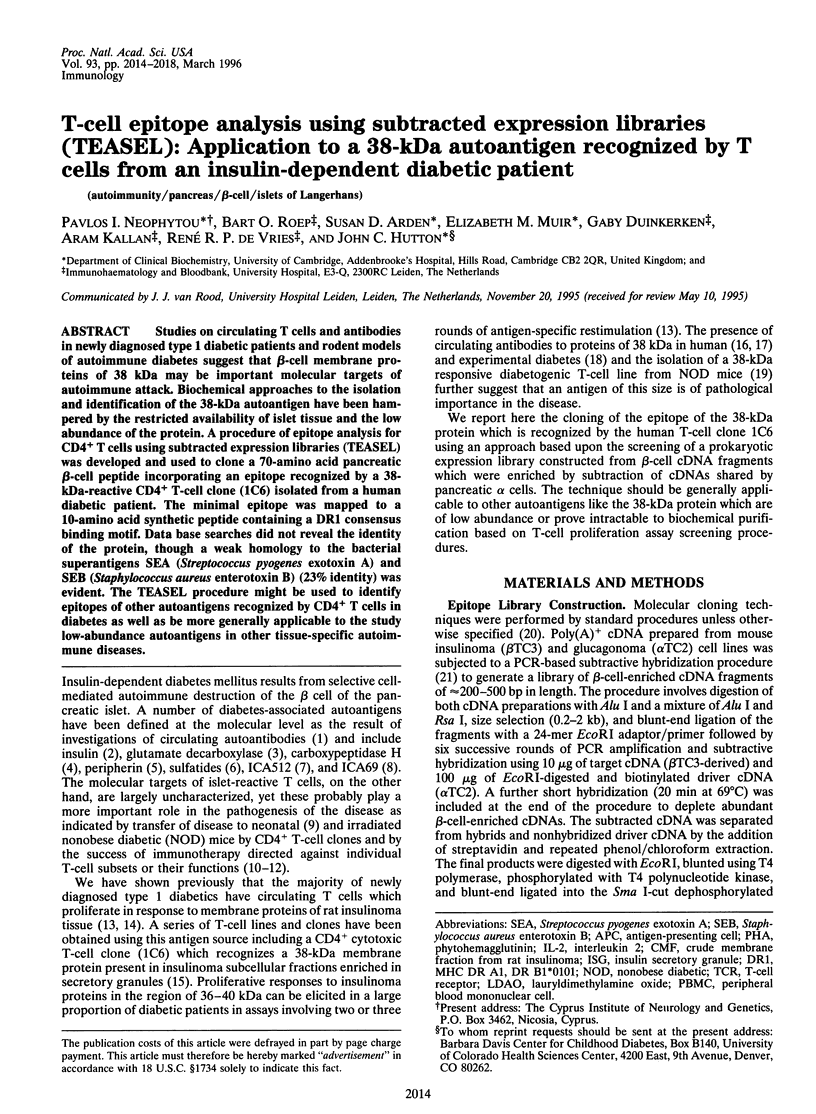
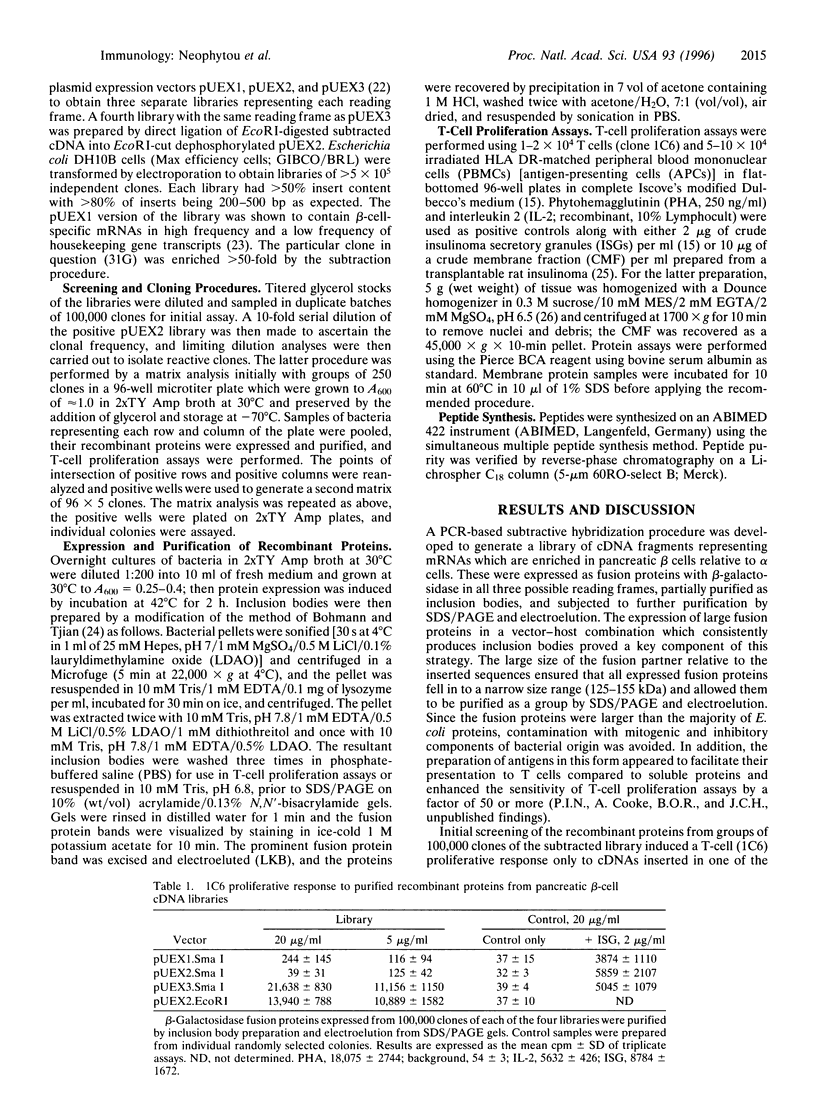
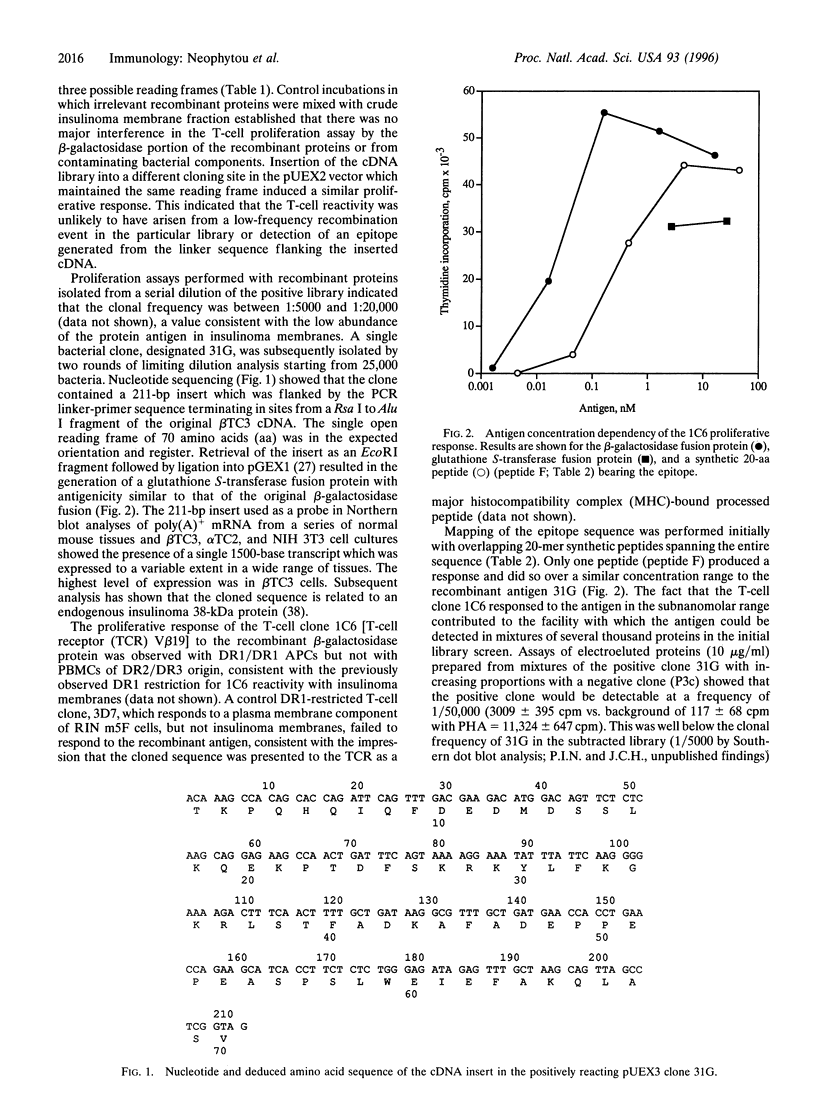
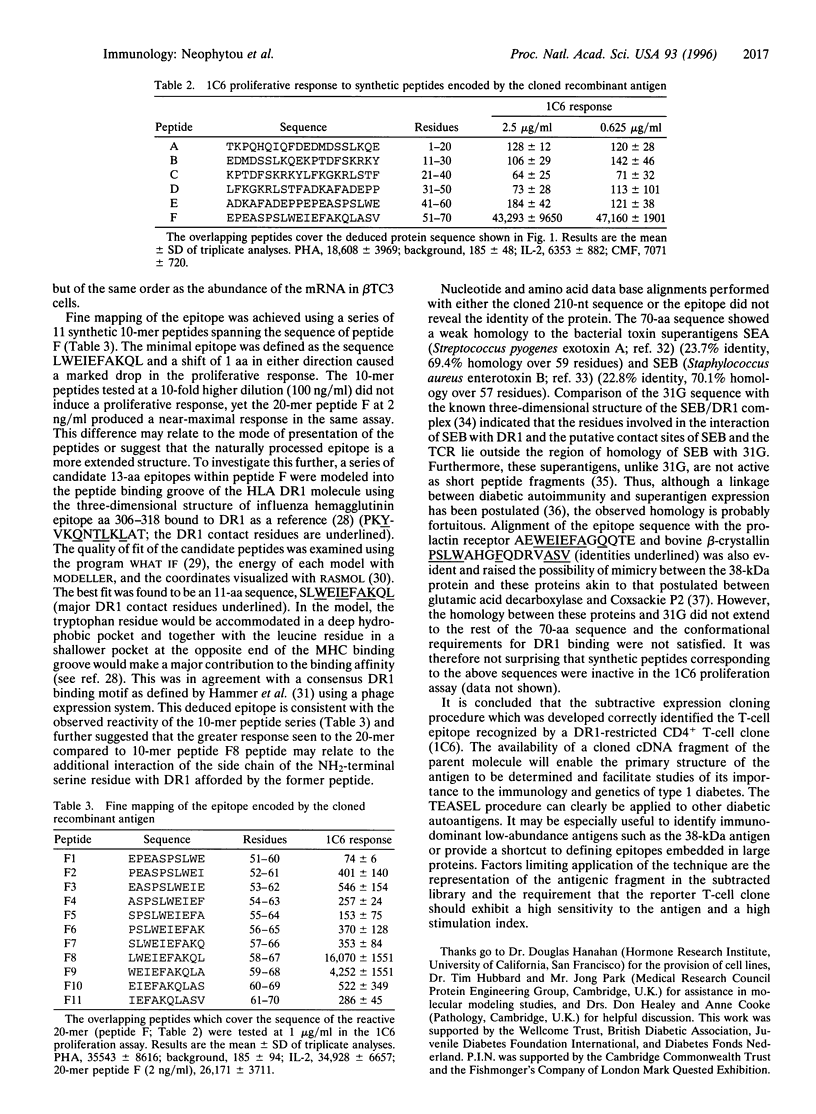
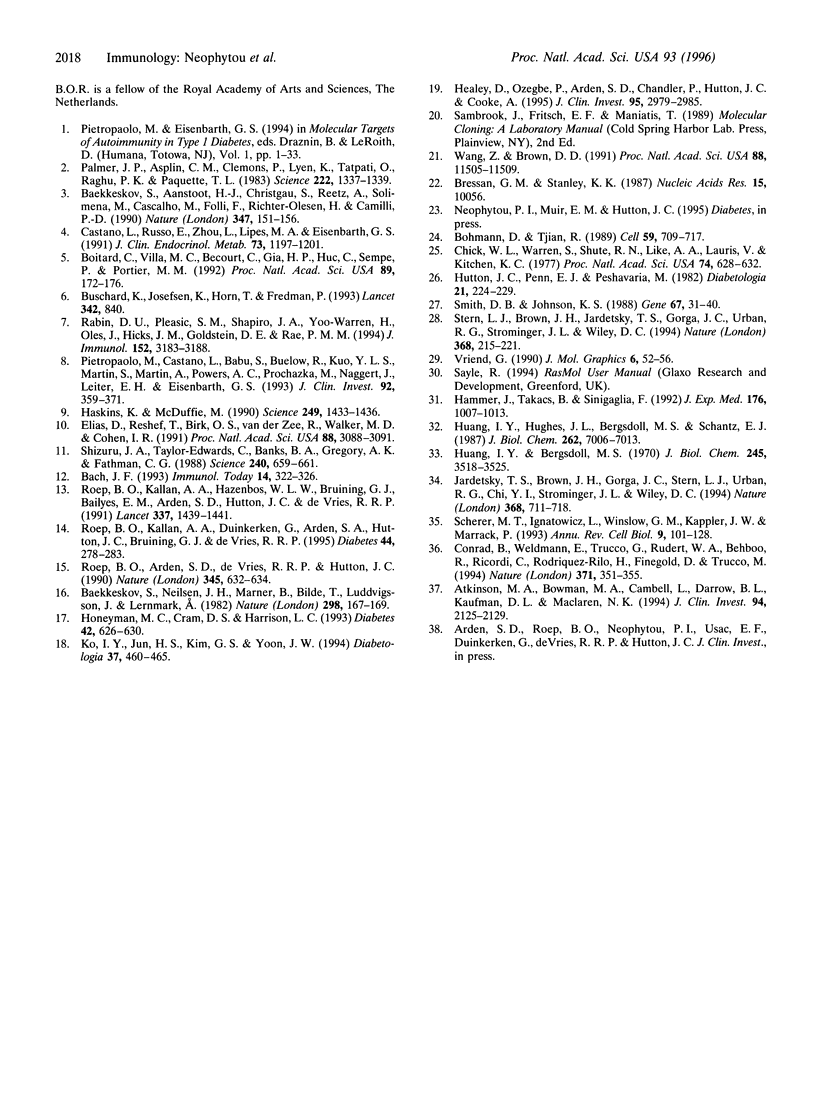
Selected References
These references are in PubMed. This may not be the complete list of references from this article.
- Atkinson M. A., Bowman M. A., Campbell L., Darrow B. L., Kaufman D. L., Maclaren N. K. Cellular immunity to a determinant common to glutamate decarboxylase and coxsackie virus in insulin-dependent diabetes. J Clin Invest. 1994 Nov;94(5):2125–2129. doi: 10.1172/JCI117567. [DOI] [PMC free article] [PubMed] [Google Scholar]
- Bach J. F. Immunosuppressive therapy of autoimmune diseases. Immunol Today. 1993 Jun;14(6):322–326. doi: 10.1016/0167-5699(93)90053-N. [DOI] [PubMed] [Google Scholar]
- Baekkeskov S., Aanstoot H. J., Christgau S., Reetz A., Solimena M., Cascalho M., Folli F., Richter-Olesen H., De Camilli P., Camilli P. D. Identification of the 64K autoantigen in insulin-dependent diabetes as the GABA-synthesizing enzyme glutamic acid decarboxylase. Nature. 1990 Sep 13;347(6289):151–156. doi: 10.1038/347151a0. [DOI] [PubMed] [Google Scholar]
- Baekkeskov S., Nielsen J. H., Marner B., Bilde T., Ludvigsson J., Lernmark A. Autoantibodies in newly diagnosed diabetic children immunoprecipitate human pancreatic islet cell proteins. Nature. 1982 Jul 8;298(5870):167–169. doi: 10.1038/298167a0. [DOI] [PubMed] [Google Scholar]
- Bohmann D., Tjian R. Biochemical analysis of transcriptional activation by Jun: differential activity of c- and v-Jun. Cell. 1989 Nov 17;59(4):709–717. doi: 10.1016/0092-8674(89)90017-2. [DOI] [PubMed] [Google Scholar]
- Boitard C., Villa M. C., Becourt C., Gia H. P., Huc C., Sempe P., Portier M. M., Bach J. F. Peripherin: an islet antigen that is cross-reactive with nonobese diabetic mouse class II gene products. Proc Natl Acad Sci U S A. 1992 Jan 1;89(1):172–176. doi: 10.1073/pnas.89.1.172. [DOI] [PMC free article] [PubMed] [Google Scholar]
- Bressan G. M., Stanley K. K. pUEX, a bacterial expression vector related to pEX with universal host specificity. Nucleic Acids Res. 1987 Dec 10;15(23):10056–10056. doi: 10.1093/nar/15.23.10056. [DOI] [PMC free article] [PubMed] [Google Scholar]
- Buschard K., Josefsen K., Horn T., Fredman P. Sulphatide and sulphatide antibodies in insulin-dependent diabetes mellitus. Lancet. 1993 Oct 2;342(8875):840–840. doi: 10.1016/0140-6736(93)92697-r. [DOI] [PubMed] [Google Scholar]
- Castaño L., Russo E., Zhou L., Lipes M. A., Eisenbarth G. S. Identification and cloning of a granule autoantigen (carboxypeptidase-H) associated with type I diabetes. J Clin Endocrinol Metab. 1991 Dec;73(6):1197–1201. doi: 10.1210/jcem-73-6-1197. [DOI] [PubMed] [Google Scholar]
- Chick W. L., Warren S., Chute R. N., Like A. A., Lauris V., Kitchen K. C. A transplantable insulinoma in the rat. Proc Natl Acad Sci U S A. 1977 Feb;74(2):628–632. doi: 10.1073/pnas.74.2.628. [DOI] [PMC free article] [PubMed] [Google Scholar]
- Conrad B., Weidmann E., Trucco G., Rudert W. A., Behboo R., Ricordi C., Rodriquez-Rilo H., Finegold D., Trucco M. Evidence for superantigen involvement in insulin-dependent diabetes mellitus aetiology. Nature. 1994 Sep 22;371(6495):351–355. doi: 10.1038/371351a0. [DOI] [PubMed] [Google Scholar]
- Elias D., Reshef T., Birk O. S., van der Zee R., Walker M. D., Cohen I. R. Vaccination against autoimmune mouse diabetes with a T-cell epitope of the human 65-kDa heat shock protein. Proc Natl Acad Sci U S A. 1991 Apr 15;88(8):3088–3091. doi: 10.1073/pnas.88.8.3088. [DOI] [PMC free article] [PubMed] [Google Scholar]
- Hammer J., Takacs B., Sinigaglia F. Identification of a motif for HLA-DR1 binding peptides using M13 display libraries. J Exp Med. 1992 Oct 1;176(4):1007–1013. doi: 10.1084/jem.176.4.1007. [DOI] [PMC free article] [PubMed] [Google Scholar]
- Haskins K., McDuffie M. Acceleration of diabetes in young NOD mice with a CD4+ islet-specific T cell clone. Science. 1990 Sep 21;249(4975):1433–1436. doi: 10.1126/science.2205920. [DOI] [PubMed] [Google Scholar]
- Healey D., Ozegbe P., Arden S., Chandler P., Hutton J., Cooke A. In vivo activity and in vitro specificity of CD4+ Th1 and Th2 cells derived from the spleens of diabetic NOD mice. J Clin Invest. 1995 Jun;95(6):2979–2985. doi: 10.1172/JCI118006. [DOI] [PMC free article] [PubMed] [Google Scholar]
- Honeyman M. C., Cram D. S., Harrison L. C. Transcription factor jun-B is target of autoreactive T-cells in IDDM. Diabetes. 1993 Apr;42(4):626–630. doi: 10.2337/diab.42.4.626. [DOI] [PubMed] [Google Scholar]
- Huang I. Y., Bergdoll M. S. The primary structure of staphylococcal enterotoxin B. 3. The cyanogen bromide peptides of reduced and aminoethylated enterotoxin B, and the complete amino acid sequence. J Biol Chem. 1970 Jul 25;245(14):3518–3525. [PubMed] [Google Scholar]
- Huang I. Y., Hughes J. L., Bergdoll M. S., Schantz E. J. Complete amino acid sequence of staphylococcal enterotoxin A. J Biol Chem. 1987 May 25;262(15):7006–7013. [PubMed] [Google Scholar]
- Jardetzky T. S., Brown J. H., Gorga J. C., Stern L. J., Urban R. G., Chi Y. I., Stauffacher C., Strominger J. L., Wiley D. C. Three-dimensional structure of a human class II histocompatibility molecule complexed with superantigen. Nature. 1994 Apr 21;368(6473):711–718. doi: 10.1038/368711a0. [DOI] [PubMed] [Google Scholar]
- Ko I. Y., Jun H. S., Kim G. S., Yoon J. W. Studies on autoimmunity for initiation of beta-cell destruction. X. Delayed expression of a membrane-bound islet cell-specific 38 kDa autoantigen that precedes insulitis and diabetes in the diabetes-prone BB rat. Diabetologia. 1994 May;37(5):460–465. doi: 10.1007/s001250050132. [DOI] [PubMed] [Google Scholar]
- Palmer J. P., Asplin C. M., Clemons P., Lyen K., Tatpati O., Raghu P. K., Paquette T. L. Insulin antibodies in insulin-dependent diabetics before insulin treatment. Science. 1983 Dec 23;222(4630):1337–1339. doi: 10.1126/science.6362005. [DOI] [PubMed] [Google Scholar]
- Pietropaolo M., Castaño L., Babu S., Buelow R., Kuo Y. L., Martin S., Martin A., Powers A. C., Prochazka M., Naggert J. Islet cell autoantigen 69 kD (ICA69). Molecular cloning and characterization of a novel diabetes-associated autoantigen. J Clin Invest. 1993 Jul;92(1):359–371. doi: 10.1172/JCI116574. [DOI] [PMC free article] [PubMed] [Google Scholar]
- Rabin D. U., Pleasic S. M., Shapiro J. A., Yoo-Warren H., Oles J., Hicks J. M., Goldstein D. E., Rae P. M. Islet cell antigen 512 is a diabetes-specific islet autoantigen related to protein tyrosine phosphatases. J Immunol. 1994 Mar 15;152(6):3183–3188. [PubMed] [Google Scholar]
- Roep B. O., Arden S. D., de Vries R. R., Hutton J. C. T-cell clones from a type-1 diabetes patient respond to insulin secretory granule proteins. Nature. 1990 Jun 14;345(6276):632–634. doi: 10.1038/345632a0. [DOI] [PubMed] [Google Scholar]
- Roep B. O., Kallan A. A., Duinkerken G., Arden S. D., Hutton J. C., Bruining G. J., de Vries R. R. T-cell reactivity to beta-cell membrane antigens associated with beta-cell destruction in IDDM. Diabetes. 1995 Mar;44(3):278–283. doi: 10.2337/diab.44.3.278. [DOI] [PubMed] [Google Scholar]
- Roep B. O., Kallan A. A., Hazenbos W. L., Bruining G. J., Bailyes E. M., Arden S. D., Hutton J. C., de Vries R. R. T-cell reactivity to 38 kD insulin-secretory-granule protein in patients with recent-onset type 1 diabetes. Lancet. 1991 Jun 15;337(8755):1439–1441. doi: 10.1016/0140-6736(91)93127-u. [DOI] [PubMed] [Google Scholar]
- Scherer M. T., Ignatowicz L., Winslow G. M., Kappler J. W., Marrack P. Superantigens: bacterial and viral proteins that manipulate the immune system. Annu Rev Cell Biol. 1993;9:101–128. doi: 10.1146/annurev.cb.09.110193.000533. [DOI] [PubMed] [Google Scholar]
- Shizuru J. A., Taylor-Edwards C., Banks B. A., Gregory A. K., Fathman C. G. Immunotherapy of the nonobese diabetic mouse: treatment with an antibody to T-helper lymphocytes. Science. 1988 Apr 29;240(4852):659–662. doi: 10.1126/science.2966437. [DOI] [PubMed] [Google Scholar]
- Smith D. B., Johnson K. S. Single-step purification of polypeptides expressed in Escherichia coli as fusions with glutathione S-transferase. Gene. 1988 Jul 15;67(1):31–40. doi: 10.1016/0378-1119(88)90005-4. [DOI] [PubMed] [Google Scholar]
- Sopwith A. M., Hutton J. C., Naber S. P., Chick W. L., Hales C. N. Insulin secretion by a transplantable rat islet cell tumour. Diabetologia. 1981 Sep;21(3):224–229. doi: 10.1007/BF00252658. [DOI] [PubMed] [Google Scholar]
- Stern L. J., Brown J. H., Jardetzky T. S., Gorga J. C., Urban R. G., Strominger J. L., Wiley D. C. Crystal structure of the human class II MHC protein HLA-DR1 complexed with an influenza virus peptide. Nature. 1994 Mar 17;368(6468):215–221. doi: 10.1038/368215a0. [DOI] [PubMed] [Google Scholar]
- Vriend G. WHAT IF: a molecular modeling and drug design program. J Mol Graph. 1990 Mar;8(1):52-6, 29. doi: 10.1016/0263-7855(90)80070-v. [DOI] [PubMed] [Google Scholar]
- Wang Z., Brown D. D. A gene expression screen. Proc Natl Acad Sci U S A. 1991 Dec 15;88(24):11505–11509. doi: 10.1073/pnas.88.24.11505. [DOI] [PMC free article] [PubMed] [Google Scholar]


